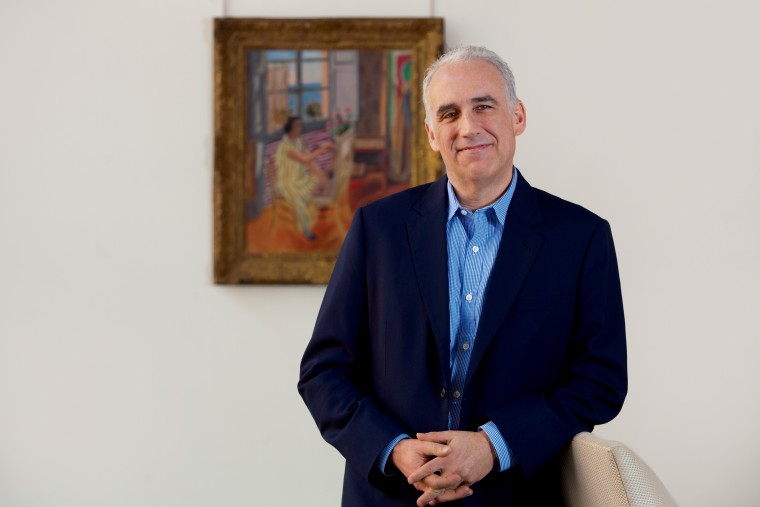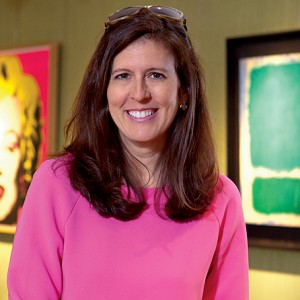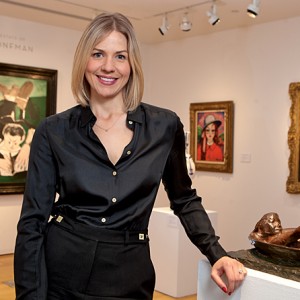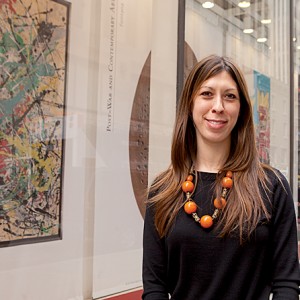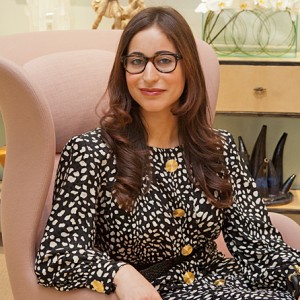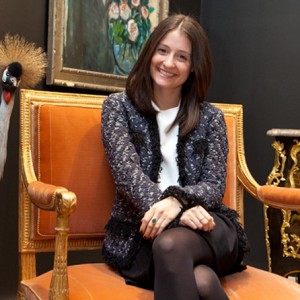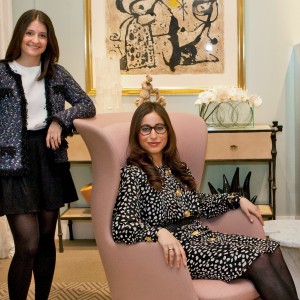David Norman, co-chairman of Impressionist and Modern Art Worldwide at Sotheby’s, will never forget the day he and three colleagues flew from London on a secret mission to a warehouse on the outskirts of Oslo, Norway.
There, in a cold bare room, lit by a single fluorescent light, they had their first look at the iconic 1895 pastel of Edvard Munch’s “The Scream,” one of four versions in existence.
There, in a cold bare room, lit by a single fluorescent light, they had their first look at the iconic 1895 pastel of Edvard Munch’s The Scream, one of four versions in existence and the only one still in private hands.
“Before us was the most familiar image in the world, yet it was a shocking surprise to us,” wrote Norman, AB ’82, in his blog in 2012. The three saw blazing red-orange and lemon yellow currents streaming across the sky, setting off the near-lapis blues and verdant greens of the harbor and landscape. “A work that expressed misery was also a work of dazzling color.”
Back in his Manhattan office filled with art books, almost two years since Sotheby’s sold Munch’s pastel for what was then a record-shattering $120 million, the former art history major still savors the experience of intimacy with a great work. “When you handle something like that, you get so immersed in the history of it,” Norman says. “We also get to live so intensely with the object, having it out of the frame, putting on white gloves to handle and examine the paper, staring at the little encrusted areas of pastels. Everyone was giving interviews, and we were writing essays. It was a stunningly exciting moment.”
And, certainly, there have been many such moments in Norman’s 29-year career at the venerable auction house. “Every day I feel incredibly lucky,” he says.
That feeling of enormous good fortune and privilege is a sentiment shared by all the Washington University alumni working in the high-stakes, fast-paced auction world.
“When I started, I really felt as if I had found where I was meant to be,” says Sheri Farber, BSBA ’89, a senior vice president in the chairman’s office of Christie’s. “And ironically, 24 years later, I still feel the same way. I am so happy that I ended up here.”
Despite their different backgrounds and fields of expertise, these alumni share some important traits: They revel in the excitement of the chase and the sheer adrenaline rush of the auction floor. They revere the art they discover and value the long-term relationships with their global clientele. They’ve all worked hard, but also benefited from their share of serendipity.
Campus Inspirations
Norman entered Washington University as a pre-med major and assumed that, like his father, he’d become a doctor. But, he says, he “faltered” in sciences and began seeking another path. In the process, he found his passion. It all started with his first art history class, a survey course called “Art and Architecture 101,” which motivated him to take more classes in the field: “The professor who really excited me was Nelson Wu, who taught Chinese, Asian and Indian art. It was one of the first times I remember absolutely loving studying.”
Norman graduated with an art history degree, but his dad reminded him that he could always make up his pre-med requirements at Columbia. He never did. Instead, Norman moved to New York and spent two years wandering the streets of SoHo with his résumé. His lucky break came in 1985, when he landed a temp job at Sotheby’s, thanks to his typing skills. And he never looked back.
Neither did Farber, a student in the Olin Business School, who originally thought she’d become a stockbroker or investment banker. But she adored art, after years of childhood museum and gallery trips. “Every free class that I had I would take an art history class,” she recalls. Farber fought to spend a semester abroad in Florence during her junior year to study art. “People in the business school didn’t quite understand what it had to do with my business degree, but it was amazing.”
“Then I thought, ‘I’m going to look in the art world.’ I decided I could always try finance later, but I may as well go with something that I really loved.”
Sheri Farber
As her senior year was winding down, Farber interviewed for typical finance jobs. “Then I thought, ‘I’m going to look in the art world,’” she says. “I decided I could always try finance later, but I may as well go with something that I really loved.” She’d heard about Christie’s from two acquaintances and blanketed the auction house with her résumé. The strategy worked: She took an entry-level job as a clerk in the bids department and later moved to Estates and Appraisals, the best place to combine her interests in business and art. “I realized I didn’t want to be a specialist. I wanted to be on the business-getting side,” Farber says.
In 2010, she joined the chairman’s office, where she devotes herself to drumming up more business for Christie’s: “I still maintain and build relationships with clients because trust is everything.” Last year, Farber logged a dozen trips around the world, from Brazil to Europe to Asia.
For Hannah Solomon, AB ’05, a double major in art history and classical studies and president of her sorority, Alpha Epsilon Phi, her first big break came after getting matched up with a trustee on Leadership Day. She told him about her passion for art history, and he offered to set her up with a summer internship at Christie’s. “I couldn’t believe what an unbelievable break it was, as Christie’s was my ideal job,” Solomon says.
Today, after earning two master’s degrees in art history and archaeology and serving a stint as an administrator in the Chinese department at Christie’s, Solomon is living her dream of working in the antiquities field. She is currently an associate specialist in the Antiquities department, working to prepare the catalog for the biannual auctions in New York by researching the objects and their provenance.
Kate Flitcroft, AB ’04, a specialist in Christie’s Silver department in London and an auctioneer, had always thought she would eventually take over her father’s architectural firm. But his sudden death, shortly before the start of her freshman year, threw her well-laid plans into disarray. Although she continued her architecture studies, she began to consider other career options. She got her first exposure to the world of collecting from a good friend and eventual roommate, whom she first met in Givens Hall (architecture school). “Her parents collected arts-and-crafts furniture, and I thought that was incredible,” Flitcroft says. It was also at their home where she saw her very first Christie’s catalog.
Flitcroft says her architectural training helps her to this day: “I can pick up that piece of silver and ask, ‘How would I make this? What is the most vulnerable part of this construction? What could have been restored?’ It talks back to what I’m doing now.”
Ups and downs
David Norman remembers when Japanese collectors dominated the bidding in the 1980s. Then, in 1991, Japan’s real estate bubble burst and property prices plummeted. The Japanese buyers completely withdrew from the market, and sales fell to just one-third of the previous year. “This was my first experience of an absolute crash in the market,” he says.
But he would live through many more booms and busts. After the Japanese collectors disappeared, along came the U.S. hedge-fund managers, then the Russian oligarchs and, after that, the Chinese. And in the last few years, wealthy Brazilians and Indians have joined in, Norman says: “In the past, people would enter the market with the lower-value sales. These days, collectors enter the market at the top.”
True to form, the art market rebounded from the recession that began after the collapse of Lehman Brothers in 2008 — and has reached new heights. At Christie’s 2013 Post-War and Contemporary Art evening sale last November, the crowd burst into applause as Francis Bacon’s triptych, Three Studies of Lucian Freud, sold for $142.4 million in 10 frenzied minutes, bumping The Scream off its pedestal as the priciest artwork ever sold at auction. “The craziness of November with work after work selling for astronomical prices still is a thriller,” Sheri Farber says.
All in a day’s work
The auction business sounds glamorous — dining with rich collectors, jetting around the world to view priceless works, participating in the excitement of lightning-fast bidding as prices climb into the stratosphere. But mostly, it’s just hard work and brutally competitive.
What keeps us up is wondering whether we’ve got enough paintings to meet the company’s target, and are we or aren’t we going to lose this piece of business to Christie’s,” Norman says. “It’s Coke and Pepsi, it’s Boeing and Airbus. To the last breath of your body, you want to beat them.”
When Flitcroft is in her London office, she can often be found cataloguing and researching silver objects for upcoming sales. “If I’m out of the office, I tend to be traveling on valuations in Europe and the U.K., usually in a very cold country house, wearing lots of layers,” she says. “I might examine 50 to 100 objects in a day.”
The flip side to her role is the more social, client-facing aspect. “I get a lot of satisfaction from helping a client from the beginning to the end of the auction process.”
After five years at the company, Flitcroft made it through Christie’s rigorous tryouts in 2012 to become an auctioneer. “As a part of my training, I auctioneered at charity events for two years before the tryouts. Being a Christie’s auctioneer is a privilege and something I’m very proud of.”
Party talk
At cocktail parties, people often ask Hannah Solomon if she can help them sell something. “Usually, it’s completely out of my field,” she says. But she can always find the right person at Christie’s to deal with the inquiry.
The most common remark that’s made to Norman? “My God, what must be on your walls!” he says. “And I laugh and say, ‘I sell them, I can’t afford to buy them.’ And, ‘I have a lot of good books about Van Gogh.’”
Invariably, people ask Farber if she has ever found anything in an attic. Answer: Nothing good. And the second most popular question for this Christie’s veteran? “What exactly do you do at Sotheby’s?” People don’t know the difference, she laughs.
Robin D. Schatz is a freelance writer based in New York City.
